Reading time: 5 minutes

28.11.2023
This is A Rehearsal, the fifth edition of the Chicago Biennial curated by the Floating Museum art collective, opens a space for reflection that seeks to distance architecture from notions such as progress and industrial greatness, and at the same time create narratives related to more intimate aspects of architecture such as land, inequality and the fight for common goods. This review highlights a series of works present during the biennial that deal with these topics.
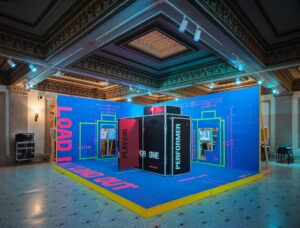
When it comes to great modern and postmodern architecture, no other city rivals Chicago. Famous for its stunning skyline, its iconic skyscrapers, its signature buildings and its black and latino neighborhoods, the city embodies a complex history and multicultural heritage written on every wall.
It is within this scenario of landmarks, public places and monuments that This Is a Rehearsal unfolds. This is the 5th edition of the Chicago Biennial curated by art collective Floating Museum. The biennial distances itself from the grandiosity that stems from its buildings and immense skyscrapers, to delve into the more intimate relationships “on how contemporary environmental, political, and economic issues are shared––yet are addressed differently around the world through art, architecture, infrastructure, and civic participation”. The curatorial approach understands architecture as something fundamental to care and improve urban life as it ultimately shelters and constrains the daily experiences of our body. The biennial is scattered around the city with more than 100 activations with artists, designers, architects, collectives and other creative practitioners whose work spans urban planning, community organizing, performance and farming, as well as a series of partnerships with public parks, municipal departments and community-based nonprofits.
This is a Rehearsal is an attempt, a trial, a test of sorts that invites us to consider cities not only as something that is in flux, but something that must be made collectively and from a myriad of pathways. In this sense, it is fundamental to rethink, reimagine and reflect on architecture to see the possibilities that escape our present. How is architecture thinking about the pressing issues of our time? How is architecture, rather than acting alone, making alliances with art, design and communities? Are monuments a way to remember or a way to keep forgetting and forgiving? Who is left out when making decisions that belong to the citizens?
A fundamental interest of the Floating Museum was to convey the political issues regarding occupation of space, dispossession, ecology, property and frontiers. Behind these questions floating around the biennale was that behind the building culture, lies the notion of the land as something that precedes architecture. Talking about land transports us irrevocably to a proto-capitalist understanding of the world, one with primitive accumulation and the commencement of enclosures, colonization, inequity, displacement and exploitation. The brutal dynamics of capitalization were not only transfigured in the infrastructure of a city, but rather in the dispossession of communities and exploitation of all sources of life present on our planet.
This review highlights a series of works present during the biennial that are entangled with the notion of land, inequality and a fight for the commons; not as a matter of private property but of public appropriation. Some times poetic, some others political, there seems to be a struggle around the world that encourages the individuals’ creativity to engage in their own space and create common places; a shared space that belongs to all.
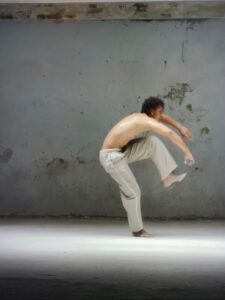
The distance between two points is not always a straight line by SKETCH–an architecture firm based in Panama–presents a two-channel video where dancers explore their stories of personal growth in their urban and social environments: the neighborhoods of Santa Ana, Barraza and El Chorrillo, highlighting Panama’s extreme inequality and gentrification where skyscrapers dialogue with communities submerged in cycles of poverty. “If I can’t dance I don’t want to be part of your revolution”. As Emma Goldamn reminds us, a beautiful ideal, for release and freedom from convention and prejudice, should not demand the denial of life and joy. SKETCH uses contemporary dance as a means to rebuild the city, remodeling its dance studios, workshops and study rooms, counteracting the adverse effects of Panama’s urban planning and architecture.
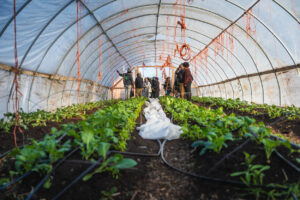 And that where SKETCH uses the dance and the movement of the body for a deeper relationship with the individual’s surroundings, Urban Growers Collective––a black and woman led non-profit organization––, thinks of the politics of food to explore urban farming, local agriculture and the inequality of access to healthy crops. They aim to address the inequities and structural racism that exist in the food system in communities of color. Rooted in growing food, they provide opportunities for BIPOC farmers. Urban farming ultimately, reshapes and repurposes a space into a more natural approach to food production. Yet Urban Growers not only reshape the space but they make sure the access to the food arrives to communities who need it. During the biennial this farm becomes part of the offsite tours sharing their struggles and envisioning a healthier relationship with the food and its communities.
And that where SKETCH uses the dance and the movement of the body for a deeper relationship with the individual’s surroundings, Urban Growers Collective––a black and woman led non-profit organization––, thinks of the politics of food to explore urban farming, local agriculture and the inequality of access to healthy crops. They aim to address the inequities and structural racism that exist in the food system in communities of color. Rooted in growing food, they provide opportunities for BIPOC farmers. Urban farming ultimately, reshapes and repurposes a space into a more natural approach to food production. Yet Urban Growers not only reshape the space but they make sure the access to the food arrives to communities who need it. During the biennial this farm becomes part of the offsite tours sharing their struggles and envisioning a healthier relationship with the food and its communities.
On the other hand, Mapping Memories of Resistance: The Untold Story of the Occupation of the Golan Heights, located in Graham Foundation, is a collective, mobile archive that historicizes the maps, testimonies and archives to tell the story of resistance through the lens of social history and the legacy of generations of Jawlani mobilization in the face of Israeli occupation. The project centers on everyday struggles and extends its outreach to young people to include them in the narration and documentation of their own experiences. The archive is modular and in constant construction sheltering the History as a collective form, but also the stories from the subjectivities involved in the bigger tale; echoing and giving visibility to the voices, writings and images from an untold story.
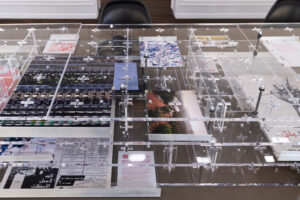
Correspondingly, 100 links is an installation by the Buell Center and AD-WO that aims to shed light on the architectural methods of North America during colonization, addressing the complex topic of architecture and land on the continent, as well as its historical significance and contemporary relevance. The installation consists of a twenty-meter chain, divided into 100 links; it unsettles the historical and ongoing dynamics of enclosure and dispossession by redefining land not as object, but as relationship. It invites visitors to move beneath sagging chains, amidst wall-mounted tags. They remind us that “to unsettle land today is to reflect on the techniques that sustain this legacy; to find solidarities across history and geography; to heed the work of contemporary abolitionists and indigenists; and to generate robust forms of unlanded freedom”1.
History has taught us that architecture is a symbol of progress and nationhood, but what if we stop thinking of it like that and instead think of it as a shelter; a shared space, a common ground for multiple stories to be conveyed, claiming what belongs to the citizens. This Is A Rehearsal is precisely an attempt to escape the narratives of the customary histories of architecture and reflect on the many untold stories shared by the ones who inhabit the space.
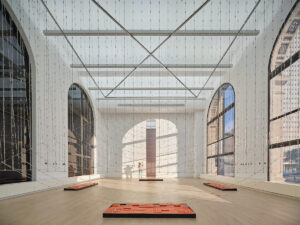
[1] https://buellcenter.columbia.edu/projects/100-links-installation-5th-chicago-architecture-biennial-2023
23.03.2024
Opinion Cartografía sentimental de la brutalización en curso Argentina, Latinoamérica
Duen Sacchi
22.03.2024
Marginalia
(Español) La Revuelta
08.03.2024
Opinion
María Galindo
Comments
There are no coments available.